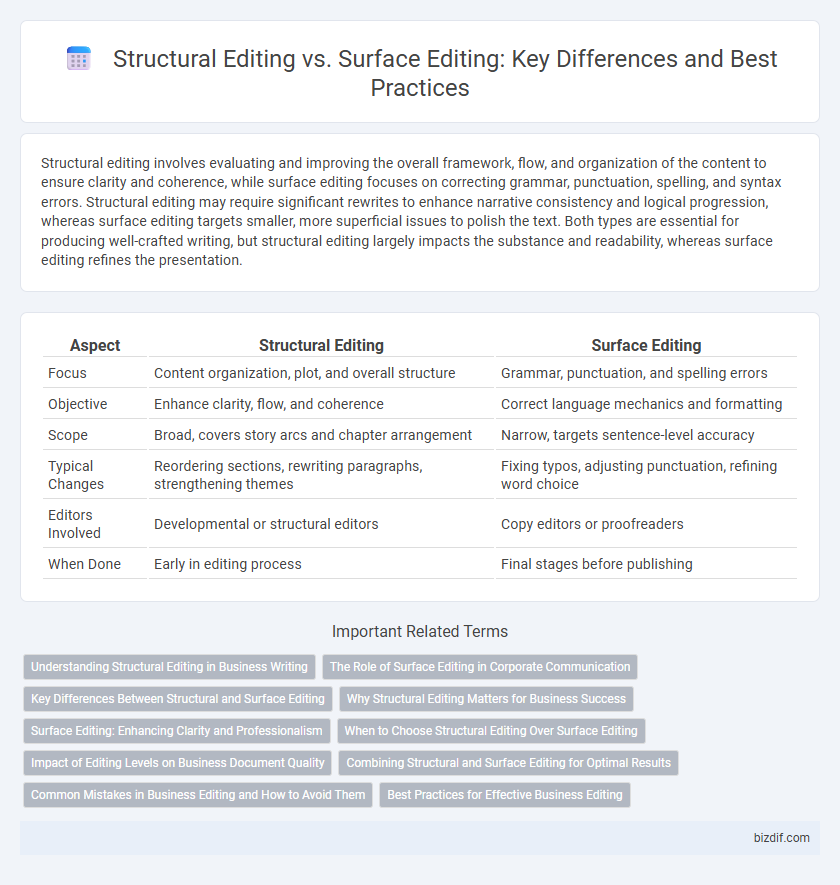Structural editing involves evaluating and improving the overall framework, flow, and organization of the content to ensure clarity and coherence, while surface editing focuses on correcting grammar, punctuation, spelling, and syntax errors. Structural editing may require significant rewrites to enhance narrative consistency and logical progression, whereas surface editing targets smaller, more superficial issues to polish the text. Both types are essential for producing well-crafted writing, but structural editing largely impacts the substance and readability, whereas surface editing refines the presentation.
Table of Comparison
| Aspect | Structural Editing | Surface Editing |
|---|---|---|
| Focus | Content organization, plot, and overall structure | Grammar, punctuation, and spelling errors |
| Objective | Enhance clarity, flow, and coherence | Correct language mechanics and formatting |
| Scope | Broad, covers story arcs and chapter arrangement | Narrow, targets sentence-level accuracy |
| Typical Changes | Reordering sections, rewriting paragraphs, strengthening themes | Fixing typos, adjusting punctuation, refining word choice |
| Editors Involved | Developmental or structural editors | Copy editors or proofreaders |
| When Done | Early in editing process | Final stages before publishing |
Understanding Structural Editing in Business Writing
Structural editing in business writing involves analyzing and improving the overall organization, clarity, and flow of content to ensure the message is coherent and effectively communicates the intended purpose. This process includes refining the logical order of ideas, enhancing paragraph transitions, and verifying that each section supports the primary objectives of the document. Unlike surface editing, which focuses on grammar, punctuation, and spelling, structural editing addresses the foundational elements that impact readability and engagement.
The Role of Surface Editing in Corporate Communication
Surface editing enhances corporate communication by refining grammar, punctuation, and style to ensure clarity and professionalism. This level of editing corrects inconsistencies in tone and formatting that can impact brand perception and audience trust. Effective surface editing supports coherent messaging and strengthens the organization's credibility in external and internal communications.
Key Differences Between Structural and Surface Editing
Structural editing involves revising the overall framework, organization, and content flow of a manuscript, addressing plot inconsistencies, character development, and thematic coherence. Surface editing focuses on correcting grammar, punctuation, spelling, and formatting errors to enhance readability and polish the text. Key differences lie in the scope and depth of edits: structural editing reshapes the narrative structure, while surface editing refines the language and technical details.
Why Structural Editing Matters for Business Success
Structural editing enhances business success by improving the clarity, coherence, and flow of content, ensuring that key messages resonate with target audiences. It identifies and fixes fundamental issues in organization, narrative, and argumentation, leading to more persuasive and impactful communication. Prioritizing structural editing reduces misunderstandings, strengthens brand authority, and drives customer engagement and conversion.
Surface Editing: Enhancing Clarity and Professionalism
Surface editing focuses on refining grammar, punctuation, spelling, and syntax to enhance clarity and professionalism in a document. It ensures consistency in style, corrects typographical errors, and improves sentence flow to engage readers effectively. This editing stage is crucial for polishing the final draft, making the text error-free and easier to comprehend.
When to Choose Structural Editing Over Surface Editing
Structural editing is essential when a manuscript requires comprehensive reorganization of content, plot development, or character arcs to improve overall coherence and flow. Authors facing issues with narrative structure, pacing, or thematic clarity should prioritize structural editing over surface editing, which focuses primarily on grammar, punctuation, and stylistic consistency. Choosing structural editing early in the revision process ensures a stronger foundation before attending to finer language details.
Impact of Editing Levels on Business Document Quality
Structural editing enhances business document quality by improving organization, clarity, and logical flow, leading to stronger communication and better decision-making. Surface editing corrects grammar, punctuation, and formatting errors, ensuring professionalism and readability but does not address content issues. Prioritizing structural editing yields higher impact on business outcomes by aligning documents with strategic goals and audience needs.
Combining Structural and Surface Editing for Optimal Results
Combining structural and surface editing enhances manuscript quality by addressing both overarching content flow and detailed language mechanics. Structural editing reorganizes plot, pacing, and character development while surface editing targets grammar, punctuation, and syntax errors. This dual approach ensures a coherent narrative enriched with polished prose, resulting in a professional and engaging final draft.
Common Mistakes in Business Editing and How to Avoid Them
Common mistakes in business editing often involve confusing structural editing with surface editing, leading to overlooked organizational issues and ineffective communication. Focusing solely on grammar and punctuation without addressing content flow or clarity can result in misaligned messaging and reduced reader engagement. To avoid these errors, prioritize a comprehensive review of document structure before refining language details, ensuring both coherence and correctness.
Best Practices for Effective Business Editing
Structural editing emphasizes the overall organization, coherence, and flow of a business document, focusing on aligning content with strategic objectives and audience needs. Surface editing targets grammar, punctuation, and style consistency to ensure clarity and professionalism in communication. Effective business editing integrates both approaches by first refining the document's structure before polishing language details, enhancing both message impact and readability.
Structural editing vs Surface editing Infographic

 bizdif.com
bizdif.com